british
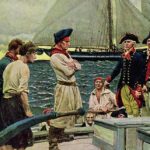
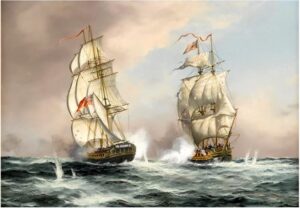 During the Revolutionary War, the United States, being a small start-up nation did not have huge amounts of funds to build a strong navy to fight against the influx of British ships sent to try to force our nation back under the rule of Great Britain, so being the resourceful nation they were, the Continental Congress made the decision to give privateers permission to attack any and all British ships on April 3, 1776. The bill was signed by John Hancock, president of the Continental Congress at that time. The bill issued “INSTRUCTIONS to the COMMANDERS of Private Ships or vessels of War, which shall have Commissions of Letters of Marque and Reprisal, authorizing them to make Captures of British Vessels and Cargoes.”
During the Revolutionary War, the United States, being a small start-up nation did not have huge amounts of funds to build a strong navy to fight against the influx of British ships sent to try to force our nation back under the rule of Great Britain, so being the resourceful nation they were, the Continental Congress made the decision to give privateers permission to attack any and all British ships on April 3, 1776. The bill was signed by John Hancock, president of the Continental Congress at that time. The bill issued “INSTRUCTIONS to the COMMANDERS of Private Ships or vessels of War, which shall have Commissions of Letters of Marque and Reprisal, authorizing them to make Captures of British Vessels and Cargoes.”
The private commercial ships were given “Letters of Marque and Reprisal” which were the official documents by which 18th-century governments commissioned private commercial ships, known as privateers, to act on their behalf. With these documents, they were officially allowed to start attacking ships carrying the flags of enemy nations. The motivation for the “assignments” was that any goods captured by the privateer were to be divided between the ship’s owner and the government that had issued the letter. It was a pretty good deal for the privateer, because they could then sell or use the good, or sell them for a profit. It was also a good deal for the government, because the received half of the “spoils” and they didn’t have to pay the privateer. As for the British ships…well, the deal was not so good.
The orders given to the privateers by Congress were “YOU may, by Force of Arms, attack, subdue, and take all Ships and other Vessels belonging to the Inhabitants of Great Britain, on the high seas, or between high-water and low-water Marks, except Ships and Vessels bringing Persons who intend to settle and reside in the United Colonies, or bringing Arms, Ammunition or Warlike Stores to the said Colonies, for the Use of such Inhabitants thereof as are Friends to the American Cause, which you shall suffer to pass unmolested, the Commanders thereof permitting a peaceable Search, and giving satisfactory Information of the Contents of the Ladings, and Destinations of the Voyages.”
The reality was that whether they were called privateers or pirates, the real distinction between the two was non-existent, at least to those who faced them on the high seas. The men were given the right to behave just 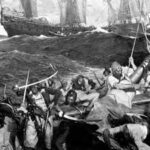
 like pirates, so they behaved just like pirates, boarding and capturing ships and using force if necessary. The good news for the privateers was that privateers holding Letters of Marque were not subject to prosecution by their home nation and, if captured, were treated as prisoners of war instead of criminals by foreign nations. Even if they were caught, this was the best-case scenario for the privateers, and they were the best thing for this country at that important time in our history.
like pirates, so they behaved just like pirates, boarding and capturing ships and using force if necessary. The good news for the privateers was that privateers holding Letters of Marque were not subject to prosecution by their home nation and, if captured, were treated as prisoners of war instead of criminals by foreign nations. Even if they were caught, this was the best-case scenario for the privateers, and they were the best thing for this country at that important time in our history.
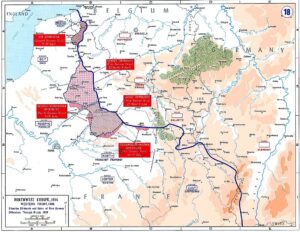
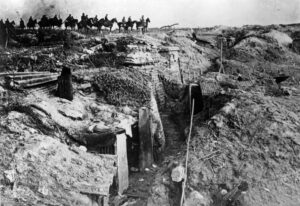 A series of German attacks along the Western Front during the First World War, beginning on March 21, 1918, known as the German Spring offensive, was also known as the Ludendorff offensive or Kaiserschlacht, which translates to Kaiser’s Battle. When the Americans entered World War I, in April 1917, the Germans knew that their days were numbered. It was decided that there was really only one way to have a chance of defeating the Allies, and that was an attack that would take place before the United States could ship soldiers across the Atlantic and fully deploy its resources. The German Army gained a temporary advantage in numbers as nearly 50 divisions had been freed by the Russian defeat and withdrawal from the war in the Treaty of Brest-Litovsk.
A series of German attacks along the Western Front during the First World War, beginning on March 21, 1918, known as the German Spring offensive, was also known as the Ludendorff offensive or Kaiserschlacht, which translates to Kaiser’s Battle. When the Americans entered World War I, in April 1917, the Germans knew that their days were numbered. It was decided that there was really only one way to have a chance of defeating the Allies, and that was an attack that would take place before the United States could ship soldiers across the Atlantic and fully deploy its resources. The German Army gained a temporary advantage in numbers as nearly 50 divisions had been freed by the Russian defeat and withdrawal from the war in the Treaty of Brest-Litovsk.
As parts of the German Spring offensive, there were four separate offensives. They were codenamed Michael, Georgette, Gneisenau, and Blücher-Yorck. The main attack was Michael, which was intended to break through the Allied lines, and outflank the British forces. The British forces held the front from the Somme River to the English Channel. The ultimate goal was to defeat the British Army. Once that was achieved, it was hoped that the French would seek armistice terms. The other offensives were secondary to Michael and were designed to divert Allied forces from the main offensive effort on the Somme. The Germans really had no clear objective established before the start of the offensives and once the operations were underway, the targets of the attacks were constantly changed, depending on the tactical situation. It was clearly not well planned.
Nevertheless, the Germans began advancing, and immediately struggled to maintain the momentum, mostly due to logistical issues. The fast-moving stormtrooper units could not carry enough food and ammunition to sustain themselves for long, and the army could not move in supplies and reinforcements fast enough to assist them. It left them wide open to failure. For their part, the Allies concentrated their main forces in the essential areas, such as the approaches to the Channel Ports and the rail junction of Amiens. The areas considered strategically worthless ground, which had been devastated by years of conflict, were left lightly defended. The danger of a German breakthrough passed within a few weeks, although related fighting continued until July.
While largely unsuccessful, the German Army, nevertheless made the deepest advances either side had made on the Western Front since 1914. They re-took much ground that they had lost in 1916–17 and took some ground that they had not yet controlled. I suppose that could have been considered at least a partial success, but despite these apparent successes, the Germans also suffered heavy casualties in return for land that was of little strategic value and hard to defend. In the end, the offensive failed to deliver a blow that could save Germany from defeat, meaning it came at such a significant cost to the Germans that it was basically a defeat. 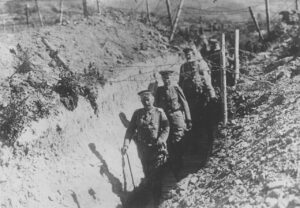
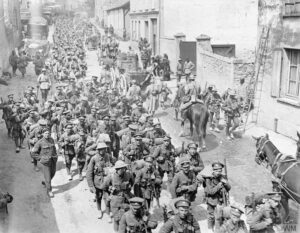 In July 1918, the Allies regained their numerical advantage with the arrival of American troops and by August, they used this and improved tactics to launch a counteroffensive. The ensuing Hundred Days Offensive resulted in the Germans losing all of the ground that they had taken in the Spring Offensive, the collapse of the Hindenburg Line, and the capitulation of Germany that November. They didn’t stand a chance.
In July 1918, the Allies regained their numerical advantage with the arrival of American troops and by August, they used this and improved tactics to launch a counteroffensive. The ensuing Hundred Days Offensive resulted in the Germans losing all of the ground that they had taken in the Spring Offensive, the collapse of the Hindenburg Line, and the capitulation of Germany that November. They didn’t stand a chance.
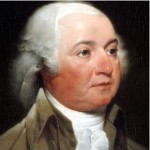
 Every politician has his trusted advisors. Often these are high ranking officials who have proven their vast political knowledge and proven that they can be trusted to keep their part of government participation on the straight and narrow for their president. However, not every advisor is a politician or someone in business, or even someone who works at all. Some seek the advice of their wives, but few to the degree of Congressman John Adams, who would later be our second president. John Adams and his wife, Abigail had an interesting political relationship. She was truly his closest confidant. When he needed advice, she was his “go-to girl” in every case. Often, Abigail would be at home maintaining the family farm in Braintree, Massachusetts while her husband was serving on the Continental Congress in Philadelphia. On March 7, 1777, Continental Congressman John Adams wrote three letters to and received two letters from his wife, Abigail.
Every politician has his trusted advisors. Often these are high ranking officials who have proven their vast political knowledge and proven that they can be trusted to keep their part of government participation on the straight and narrow for their president. However, not every advisor is a politician or someone in business, or even someone who works at all. Some seek the advice of their wives, but few to the degree of Congressman John Adams, who would later be our second president. John Adams and his wife, Abigail had an interesting political relationship. She was truly his closest confidant. When he needed advice, she was his “go-to girl” in every case. Often, Abigail would be at home maintaining the family farm in Braintree, Massachusetts while her husband was serving on the Continental Congress in Philadelphia. On March 7, 1777, Continental Congressman John Adams wrote three letters to and received two letters from his wife, Abigail.
The Adams’ correspondence was truly remarkable. Their total letters during his political career numbered 1,160 letters in total, and they covered topics ranging from politics and military strategy to household economy and 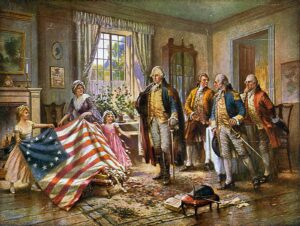 family health. For many of the years of Adams’ political career their lives were literally lived in letters. Their mutual respect and adoration showed that even in an age when women were unable to vote, there were nonetheless marriages in which wives and husbands were true intellectual and emotional equals, and the marriage between John and Abigail Adams was one of those.
family health. For many of the years of Adams’ political career their lives were literally lived in letters. Their mutual respect and adoration showed that even in an age when women were unable to vote, there were nonetheless marriages in which wives and husbands were true intellectual and emotional equals, and the marriage between John and Abigail Adams was one of those.
Normally, Congress met in Philadelphia, but in mid-December 1776 Congress decided to move to Baltimore to escape capture by the advancing British. The time in Baltimore was frustrating for the Congress. There were complaints that “the town was exceedingly expensive, and exceedingly dirty, that at times members could make their way to the assembly hall only on horseback, through deep mud.” Throughout the session there was inadequate representation from the various colonies. In those days congressmen came to meetings if they felt they could make it, but excuses for not going were often made too. Even with the shortage of representatives, Samuel Adams declared in the earlier part of the session, “We have done more important business in three weeks than we had done, and I believe should have done, at Philadelphia, in six months.” The congressmen also managed to appoint a committee of five to obtain foreign assistance.
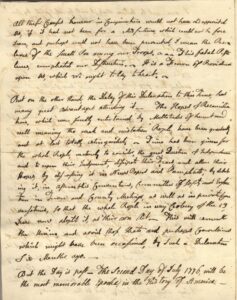
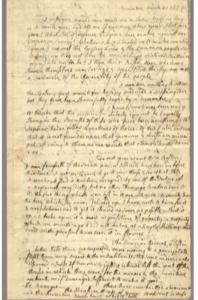 On March 7th, 1777, John drafted his second letter to Abigail. In it he declared that Philadelphia had lost its vibrancy during Congress’ removal to Baltimore. “This City is a dull Place, in Comparason [sic] of what it was. More than one half the Inhabitants have removed to the Country, as it was their Wisdom to do—the Remainder are chiefly Quakers as dull as Beetles. From these neither good is to be expected nor Evil to be apprehended. They are a kind of neutral Tribe, or the Race of the insipids.” While the Adams’ couple did what they had to do to serve their country, I’m sure the years of service were hard on the couple, but never on their marriage. Their love was genuine and forever. Their letters may have been mostly formal and businesslike, but I think that if you read between the lines their letter told so much more about the couple they were.
On March 7th, 1777, John drafted his second letter to Abigail. In it he declared that Philadelphia had lost its vibrancy during Congress’ removal to Baltimore. “This City is a dull Place, in Comparason [sic] of what it was. More than one half the Inhabitants have removed to the Country, as it was their Wisdom to do—the Remainder are chiefly Quakers as dull as Beetles. From these neither good is to be expected nor Evil to be apprehended. They are a kind of neutral Tribe, or the Race of the insipids.” While the Adams’ couple did what they had to do to serve their country, I’m sure the years of service were hard on the couple, but never on their marriage. Their love was genuine and forever. Their letters may have been mostly formal and businesslike, but I think that if you read between the lines their letter told so much more about the couple they were.

 Most Christians have heard about the Biblical battle of Jericho. If you know the story, you know that the Israelites marched around the city walls once a day for six days, then seven times on the seventh day, and the walls of Jericho fell after they shouted, and the priests blew their trumpets. That was one of the epic battles that the Israelites were involved in. Jericho took a beating that day, but since then Jericho hasn’t always lived a peaceful life since then either.
Most Christians have heard about the Biblical battle of Jericho. If you know the story, you know that the Israelites marched around the city walls once a day for six days, then seven times on the seventh day, and the walls of Jericho fell after they shouted, and the priests blew their trumpets. That was one of the epic battles that the Israelites were involved in. Jericho took a beating that day, but since then Jericho hasn’t always lived a peaceful life since then either.
On the morning of February 21, 1918, the combined Allied forces of British troops and the Australian mounted cavalry captured the city of Jericho in Palestine. The capture came after a three-day battle with Turkish troops.  The Allied troops, commanded by British General Edmund Allenby, began the offensive on Tuesday, February 19th, on the outskirts of Jerusalem. The operation was plagued by adverse weather conditions and the very determined Turkish enemy. Nevertheless, the Allies were able to move nearly 20 miles toward Jericho in just three days.
The Allied troops, commanded by British General Edmund Allenby, began the offensive on Tuesday, February 19th, on the outskirts of Jerusalem. The operation was plagued by adverse weather conditions and the very determined Turkish enemy. Nevertheless, the Allies were able to move nearly 20 miles toward Jericho in just three days.
Despite their determination, it was apparent by the morning of February 21, that the Turkish line had been broken, and the Allied forces entered the holy city of Jericho without much resistance at just after 8am. When they realized that they had lost control of the city, the Turkish troops chose to retreat rather than fight, meaning the three-day battle with the Allied troops ended much like the Biblical battle…Jericho simply surrendered. The Allies captured 46 Turkish prisoners, on that fateful day.

 Just as it had been in Biblical times, the capture of Jericho proved to be an important strategic victory for the Allies. They now controlled some of the most important roads in the region, including the main road to the coast and the mountain highway leading to Jerusalem, and they had reached the northern end of the Dead Sea, the lowest point on earth at 1,290 feet below sea level.
Just as it had been in Biblical times, the capture of Jericho proved to be an important strategic victory for the Allies. They now controlled some of the most important roads in the region, including the main road to the coast and the mountain highway leading to Jerusalem, and they had reached the northern end of the Dead Sea, the lowest point on earth at 1,290 feet below sea level.

 In 1800, President John Adams approved legislation that appropriated $5,000 to purchase “such books as may be necessary for the use of Congress.” The initial collection of books, ordered from London, arrived in 1801. These were stored in the US Capitol. The books were the library’s first. The inaugural library catalog, dated April 1802, listed 964 volumes and nine maps. The library was President Adams’ pride and joy. In 1814, in what was a largely symbolic maneuver, the British entered Washington DC and burned down the capitol and the library. The fire was dramatic, but really had little relevance, because the city didn’t have an especially large population and, since much of the US government had fled before the British could overtake them, there was little strategic value in the destruction. Nevertheless, the about 3,000 books were lost in that fire.
In 1800, President John Adams approved legislation that appropriated $5,000 to purchase “such books as may be necessary for the use of Congress.” The initial collection of books, ordered from London, arrived in 1801. These were stored in the US Capitol. The books were the library’s first. The inaugural library catalog, dated April 1802, listed 964 volumes and nine maps. The library was President Adams’ pride and joy. In 1814, in what was a largely symbolic maneuver, the British entered Washington DC and burned down the capitol and the library. The fire was dramatic, but really had little relevance, because the city didn’t have an especially large population and, since much of the US government had fled before the British could overtake them, there was little strategic value in the destruction. Nevertheless, the about 3,000 books were lost in that fire.
The Library of Congress must seem like an institution that is unable to be defeated, but the reality is that while it has been there practically forever, acting as the nation’s biggest library, it has been almost destroyed three times. The Library of Congress is one of the largest libraries in the world, with over 170 million items in its collections at present, according to the Library of Congress itself. It possesses a world class collection of rare books and holds the largest known collection of audio recordings, maps, and films, among other materials. It is accessible not only to the Congressional representatives who work nearby in the Capitol, but also to all Americans and members of the public. That was not always the case, however. At its inception, the Library of Congress was for congressional use only.
Once the fires of the British died down, they left Washington, and the American lawmakers returned. As has always been the way of Americans, they knew it was time to rebuild. While Congress was putting itself back together, it became clear that most wanted the Library of Congress to return as well. At that point, former president Thomas Jefferson stepped in. He offered to sell his own library to reconstitute the one lost in 1814. It is certainly logical that Jefferson was one proposing such a deal. According to the Library of Congress, he was an avid book reader and lifelong learner with an extensive personal library. While he committed to the notion of an informed, intellectual Congress, Jefferson may have also empathized on a deeper level. In 1770, his own home had burned, and Jefferson, gazing at the ashes, most acutely felt the loss of his books. Later, he would come to possess the largest private library in the United States.
The Library of Congress faced at least three fires in its fight to exist. In fact, its existence as an institution has been challenged numerous obstacles throughout its more than 200 years of existence. The Library of Congress faced space shortages, understaffing, and lack of funding, until the American Civil War increased the importance of legislative research to meet the demands of a growing federal government. Then, in 1870, the library gained the right to receive two copies of every copyrightable work printed in the United States. It also built its collections through acquisitions and donations. Between 1890 and 1897, a new library building, which has now 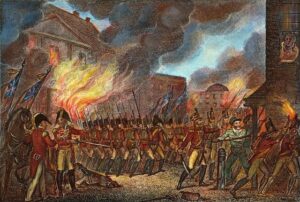
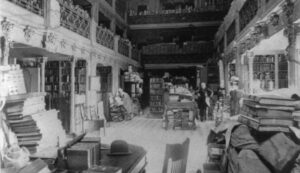 been renamed the Thomas Jefferson Building, was constructed. Two additional buildings, the John Adams Building (opened in 1939) and the James Madison Memorial Building (opened in 1980), were later added. In total, the Library of Congress has faced major fires at least three times in its history.
been renamed the Thomas Jefferson Building, was constructed. Two additional buildings, the John Adams Building (opened in 1939) and the James Madison Memorial Building (opened in 1980), were later added. In total, the Library of Congress has faced major fires at least three times in its history.
According to the United States House of Representatives, the 1825 fire occurred on the evening of December 22nd. Massachusetts Representative Edward Everett, who was leaving a nearby party, noticed a strange light coming from the library windows. When he informed a Capitol police officer, who did not have a key, Everett dismissed the situation. However, as the glow intensified, it became increasingly difficult to ignore. Eventually, more officers, along with Librarian of Congress George Watterson, discovered the dreadful truth: Library of Congress was on fire…again!!
Both representatives and firefighters fought the blaze, including’s fellow Massachusetts representative, Daniel Webster, and Tennessee politician Sam Houston. They extinguished fire before it spread to the rest of the Capitol. Ultimately, it was determined that the cause was a candle left lit in the room. The damage was not nearly as extensive as the 1814, though some books and a rug were lost.
On December 24, 1851, what is thought to be the most devastating fire destroyed 35,000 books, two-thirds of the library’s collection, and two-thirds of Jefferson’s original transfer. In 1852, Congress appropriated $168,700 to replace the books but not to acquire new materials. By 2008, the librarians of Congress had found replacements for all but 300 of the works documented as being in Jefferson’s original collection. This marked the beginning of a conservative period in the library’s administration under librarian John Silva Meehan and joint committee chairman James A. Pearce, who restricted the library’s activities. Meehan and Pearce’s views on limiting the Library of Congress’s scope were shared by members of Congress. As a librarian, Meehan and perpetuated the notion that “the congressional library should play a limited role on the national scene and its collections, by and large, should emphasize American materials obvious use to the US Congress.” In 1859, Congress transferred the library’s public document distribution activities to the Department of the Interior and its international book exchange program to the Department of State.
These days, the library is open for academic research to anyone with a Reader Identification Card. The library items may not be removed from the reading rooms or the library buildings. Most of the library’s general collection of books and journals are in the closed stacks of Jefferson and Adams Buildings. Specialized collections of books and other materials are in stacks in three main library buildings or stored off-site. Access to the closed stacks not permitted under any circumstances, except to authorized library staff and occasionally to dignitaries. Only reading room reference collections are on open shelves.

 Since 1902, American libraries have been able to request books other items through interlibrary loan from the Library of Congress, if these are not available elsewhere. Through this system, the Library of Congress has served as a “library of last resort,” according to former librarian of Congress Herbert Putnam. The Library of Congress lends books to other libraries with the stipulation that they be used only inside the borrowing library. In 2017, the Library of Congress began development of a reader’s card for children under the age of sixteen.
Since 1902, American libraries have been able to request books other items through interlibrary loan from the Library of Congress, if these are not available elsewhere. Through this system, the Library of Congress has served as a “library of last resort,” according to former librarian of Congress Herbert Putnam. The Library of Congress lends books to other libraries with the stipulation that they be used only inside the borrowing library. In 2017, the Library of Congress began development of a reader’s card for children under the age of sixteen.

 When my Aunt Sandy Pattan and I go to lunch, she will usually forego vegetables for a double portion of mashed potatoes. Her request will usually accompany her asking me if I know that she is Irish, and so the love of potatoes. Of course, I know that she is Irish, because she is my aunt, and I know about my own Irish ties through her side of the family. Nevertheless, I can’t say that I connected the Irish part with potatoes. So, I decided to do a little research to find our why “the Irish like potatoes” as my aunt says. In my research, I found probably the last thing I expected.
When my Aunt Sandy Pattan and I go to lunch, she will usually forego vegetables for a double portion of mashed potatoes. Her request will usually accompany her asking me if I know that she is Irish, and so the love of potatoes. Of course, I know that she is Irish, because she is my aunt, and I know about my own Irish ties through her side of the family. Nevertheless, I can’t say that I connected the Irish part with potatoes. So, I decided to do a little research to find our why “the Irish like potatoes” as my aunt says. In my research, I found probably the last thing I expected.
In the annals of Irish history, the potato transcends its role as a staple food; it embodies both prosperity and hardship. It was instrumental in supporting the population during times of expansion, yet it also played a pivotal role in one of Ireland’s most catastrophic episodes: the Great Famine. The story of the potato in Ireland  is a tale of how a single crop can influence the fate of a nation, weaving itself into the very fabric of the Irish cultural identity.
is a tale of how a single crop can influence the fate of a nation, weaving itself into the very fabric of the Irish cultural identity.
Few events in Irish history are as dark and devastating as the Great Hunger, also known as the Potato Famine. At that time, Ireland was a colony of Great Britain, which relied heavily on the country for potato production. However, in 1845, a devastating disease destroyed 75% of the potato crop, persisting for over five years. The local Irish population suffered the most. Estimates suggest that approximately one million Irish people died of starvation during the famine and another million emigrated. By the end of the famine in 1852, Ireland’s population had decreased by 25%. The British government faced criticism for its inadequate response, and the catastrophe fueled the drive for Irish independence. The Irish people felt that the British had not tried hard enough to take care of the people under their rule.
As often happens when a food item is no longer allowed or readily available, the Irish people loved their potatoes. The significance of the potato in Irish culture surpasses its agricultural importance, profoundly influencing culinary customs. It turned into a dietary mainstay, with creations like colcannon (mashed potatoes with kale or cabbage), boxty (potato pancakes) being a beloved dish in my Grandma Byer’s (Aunt Sandy’s mom) home, and Irish stew (potatoes, meat, and vegetables) becoming indispensable. These dishes were not 
 merely nourishing but also reflected the creativity and adaptability of Irish cooks who produced a variety of meals from a few ingredients. The simple yet hearty character of these potato-centric dishes mirrored the lives and struggles of ordinary people, ingraining these recipes in the heart of Irish cooking traditions. And with that, I feel like I now understand my aunt’s obsession with potatoes.
merely nourishing but also reflected the creativity and adaptability of Irish cooks who produced a variety of meals from a few ingredients. The simple yet hearty character of these potato-centric dishes mirrored the lives and struggles of ordinary people, ingraining these recipes in the heart of Irish cooking traditions. And with that, I feel like I now understand my aunt’s obsession with potatoes.
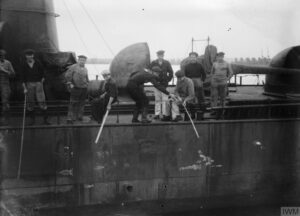
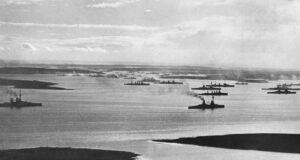 After the November 11, 1918 German surrender in World War I, the German fleet was interned at Scapa Flow under the terms of the Armistice of 11 November, while negotiations took place over its fate. There was talk of the fleet being divided between the Allied nations, and there were those who really wanted that, but this brought the fear that the British would seize the ships, and the Germans worried that if the German government at the time might rejected the Treaty of Versailles and resumed the war effort, the newly confiscated German ships could be used against Germany. Amid all the speculation, Admiral Ludwig von Reuter decided to scuttle the fleet.
After the November 11, 1918 German surrender in World War I, the German fleet was interned at Scapa Flow under the terms of the Armistice of 11 November, while negotiations took place over its fate. There was talk of the fleet being divided between the Allied nations, and there were those who really wanted that, but this brought the fear that the British would seize the ships, and the Germans worried that if the German government at the time might rejected the Treaty of Versailles and resumed the war effort, the newly confiscated German ships could be used against Germany. Amid all the speculation, Admiral Ludwig von Reuter decided to scuttle the fleet.
Scapa Flow was a naval base in the Orkney Islands in Scotland. When the German ships arrived, they had full crews and in all, there were more than 20,000 German sailors aboard, the number of sailors was reduced in the ensuing months. When the full fleet was at Scapa Flow, there were 74 ships there during negotiations between the Allies and Germany over a peace treaty that would become Versailles. The discussion was about what to do with the ships, since they didn’t really want Germany to have a full fleet ready, should they decide to wage war again. The French and Italians wanted a portion of the fleet, but the British wanted them destroyed. They were concerned about their own naval superiority, should the ships be distributed among the other Allied nations.
The Germans didn’t want their ships in the hand of their enemies, so Admiral Ludwig von Reuter began to prepare for the scuttling in May 1919, after hearing about the potential terms of the Versailles Treaty. Shortly before the treaty was signed on June 21, Reuter sent the signal to his men. The men began opening flood valves, smashing water pipes, and opening sewage tanks. As the scuttle was taking place, nine German crew members who abandoned ship and attempted to come ashore were shot by British forces. As the ships were being scuttled, the intervening British guard ships were able to beach some of the ships. In all, 52 of the 74 ships were sunk. While he wouldn’t say so out loud, British Admiral Wemyss was delighted that the ships were 
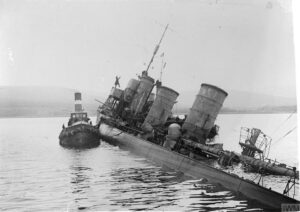 sunk, because that meant they wouldn’t be distributed to the French and Italians navies. Since the scuttling, many ships have been refloated and salvaged in the years since. Nevertheless, some remain in the seas at Scapa Flow. Those that remain are popular diving sites and a source of low-background steel.
sunk, because that meant they wouldn’t be distributed to the French and Italians navies. Since the scuttling, many ships have been refloated and salvaged in the years since. Nevertheless, some remain in the seas at Scapa Flow. Those that remain are popular diving sites and a source of low-background steel.
 A lighthouse is by definition, a tall building set on the coast with a light in its tower to warn ships of the presence of dangerous rocks or shores. I have long loved lighthouses…their history, the ships they protected, and the place you find them. These days, there might not be as much need for lighthouses, because of GPS, but GPS can fail, computers can crash, and some solar activity can affect GPS too. There are lots of reasons why it can fail, so these days, lighthouses might be considered a…backup plan. You never know when they might be needed, and that is not the time to find out that you don’t have them.
A lighthouse is by definition, a tall building set on the coast with a light in its tower to warn ships of the presence of dangerous rocks or shores. I have long loved lighthouses…their history, the ships they protected, and the place you find them. These days, there might not be as much need for lighthouses, because of GPS, but GPS can fail, computers can crash, and some solar activity can affect GPS too. There are lots of reasons why it can fail, so these days, lighthouses might be considered a…backup plan. You never know when they might be needed, and that is not the time to find out that you don’t have them.
The lighthouse at Sandy Hook, in what is now New Jersey, was put in use on June 11, 1764. It was needed badly, and the Provincial Congress of New York orchestrated two lotteries to raise money for its construction. As with many projects, things moved slowly. The lighthouse was first suggested for Sandy Hook nearly a century before, but it was finally initiated by Colonial Governor Edmund Andros. It finally became a priority 43 New York merchants, lost 20,000 pounds of sterling from shipwrecks in  early 1761. Suddenly, it was really important. to protect those ships and their cargo. In the 27 months that the light house at Sandy hook stood, she had protected many ships.
early 1761. Suddenly, it was really important. to protect those ships and their cargo. In the 27 months that the light house at Sandy hook stood, she had protected many ships.
Then, on March 6, 1776, a committee of the New York Provincial Congress instructs Major William Malcolm to dismantle the Sandy Hook lighthouse. The territory was in dispute, and Major Malcolm’s task was to prevent the lighthouse from helping the British to reach New York City. The Congress wanted Malcolm to remove the lens and lamps so that the lighthouse could no longer warn ships of the rocky shore. Major Malcolm succeeded. Colonel George Taylor reported six days later that Malcolm had “given him eight copper lamps, two tackle falls and blocks, and three casks, and a part of a cast of oil from the dismantling of the beacon.” While the removal would most certainly mean the loss of ships and lives, it was deemed collateral damage, even if some of the ships were friendlies.
While the lighthouse removal was a success, it did not keep the British from invading New York. They were soon  able to put the lighthouse back into service by installing lamps and reflectors. The Patriots attempted to knock the light out again on June 1, 1776, by placing cannon on boats and attempting to blow away the British equipment. They managed some damage before being chased away. The new states of New Jersey and New York bickered over ownership of the lighthouse, until the federal government assumed control of all US lighthouses in 1787. As of 1996, the Sandy Hook lighthouse, the oldest original lighthouse in the United States, passed into the jurisdiction of the National Park Service. I’m glad it survived all that turmoil. It would be sad if it was lost forever.
able to put the lighthouse back into service by installing lamps and reflectors. The Patriots attempted to knock the light out again on June 1, 1776, by placing cannon on boats and attempting to blow away the British equipment. They managed some damage before being chased away. The new states of New Jersey and New York bickered over ownership of the lighthouse, until the federal government assumed control of all US lighthouses in 1787. As of 1996, the Sandy Hook lighthouse, the oldest original lighthouse in the United States, passed into the jurisdiction of the National Park Service. I’m glad it survived all that turmoil. It would be sad if it was lost forever.
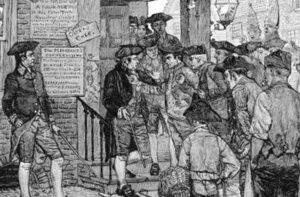
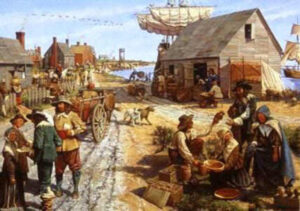 If you travel to a different area of the country or even other English-speaking areas of the world, you will find that here are different accents and even that words are used differently. Still, just because you are visiting or move to those places, doesn’t mean that you will immediately take on those accents, or their use of words. Nevertheless, when you move to a different region, your use of the language does immediately begin to evolve, whether you realize it or not, and whether it is intentional or not. The first Englishmen to set foot on American soil with the intent to colonize the land were no exception. The language began to evolve almost immediately….and it remains a fluid, almost living process to this day. “Americanisms” have been created or changed from other English terms to produce a language that very much differs from our forefathers, signifying our uniqueness and independence.
If you travel to a different area of the country or even other English-speaking areas of the world, you will find that here are different accents and even that words are used differently. Still, just because you are visiting or move to those places, doesn’t mean that you will immediately take on those accents, or their use of words. Nevertheless, when you move to a different region, your use of the language does immediately begin to evolve, whether you realize it or not, and whether it is intentional or not. The first Englishmen to set foot on American soil with the intent to colonize the land were no exception. The language began to evolve almost immediately….and it remains a fluid, almost living process to this day. “Americanisms” have been created or changed from other English terms to produce a language that very much differs from our forefathers, signifying our uniqueness and independence.
Of course, the people didn’t notice the changes right away, but by 1720, the English colonists began to notice that their language was quite different from that spoken in their Motherland. I’m sure they wondered just how that came to be? Basically, when you hear new “slang” words, and people don’t hear the accents spoken as well, the whole dynamic of the language changes. Also, very formal words like “thee, thou, and such” might become too cumbersome and so they are discarded. Everyone in the colonies knew that English would be our native language by 1790, because when the United States took its first census, there were four million Americans, 90% of whom were descendants of English colonists. So, it made perfect sense.
Nevertheless, it would not be the same as that spoken in Great Britain. The reasons are varied, but the most obvious reason was the sheer distance from England. The main way the language evolved was that over the years, many words were borrowed from the Native Americans, as well as other immigrants from France, Germany, Spain, and other countries. In addition, words that became obsolete “across the pond” continued to be utilized in the colonies. In other cases, words simply had to be created in order to explain the unfamiliar landscape, weather, animals, plants, and living conditions that these early pioneers encountered. By 1790 it was obvious that American English would be a very different language that British English.
The first “official” reference to the “American dialect” was made in 1756 by Samuel Johnson, a year after he published his Dictionary of the English Language. Johnson’s use of the term “American dialect” was not meant to simply explain the differences but rather, was intended as an insult. This “new” language was called “barbarous” and referred to our “Americanisms” as barbarisms. Because of the dissention between England and the Colonies, the British sneering at our language continued for more than a century after the Revolutionary War. They laughed and condemned as unnecessary, hundreds of American terms and phrases, but to our newly independent Americans, they were proud of their “new” American language and considered it to be another badge of independence. In 1789, Noah Webster wrote in his Dissertations on the English Language, “The reasons for American English being different than English English are simple…As an independent nation, our honor requires us to have a system of our own, in language as well as government.” In the eyes of the Colonists, that settled the matter, and when the United States was formed, the new nation was proud to be separated for the “Motherland” and would have it no other way.
Our leaders, including Thomas Jefferson and Benjamin Rush, agreed — it was not only good politics, but it was also sensible. The most atrocious changes to the British were the heavy use of contractions such as ain’t, can’t, don’t, and couldn’t. The feelings of the “rest of the world” didn’t matter to Americans, and the language changed even more during the western movement as numerous Native American and Spanish words became an everyday part of our language. The evolution of the American language continued into the 20th century and really continues even to this day. After World War I, when Americans were in a patriotic and anti-foreign mood, the state of Illinois went so far as to pass an act making the official language of the state the “American language.” In 1923, in the State of Illinois General Assembly, they passed the act stating in part, “The official language of the State of Illinois shall be known hereafter as the ‘American’ language and not as the ‘English’ 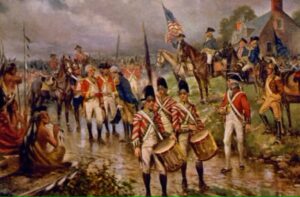
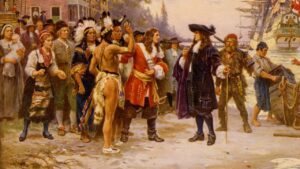 language. A similar bill was also introduced in the US House of Representatives the same year but died in committee. Ironically, after centuries of forming our ‘own’ language, the English and American versions are once again beginning to blend as movies, songs, electronics, and global traveling bring the two ‘languages’ closer together.”
language. A similar bill was also introduced in the US House of Representatives the same year but died in committee. Ironically, after centuries of forming our ‘own’ language, the English and American versions are once again beginning to blend as movies, songs, electronics, and global traveling bring the two ‘languages’ closer together.”
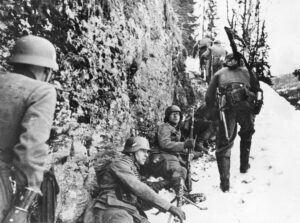 During the largely unsuccessful Norwegian Campaign of World War II, the Allies were in a fight to stop the Germans from fully occupying Norway, but it didn’t work in the end. The Norwegian campaign was carried out from April 8, 1940 to June 10, 1940, and involved the attempt by Allied forces to defend northern Norway coupled with the resistance of the Norwegian military to the country’s invasion by Nazi Germany.
During the largely unsuccessful Norwegian Campaign of World War II, the Allies were in a fight to stop the Germans from fully occupying Norway, but it didn’t work in the end. The Norwegian campaign was carried out from April 8, 1940 to June 10, 1940, and involved the attempt by Allied forces to defend northern Norway coupled with the resistance of the Norwegian military to the country’s invasion by Nazi Germany.
The Norwegian Campaign was planned as Operation Wilfred and Plan R 4, prior to the actual German attack, which the Allies knew was imminent, but had not yet happened. On April 4th, the battlecruiser HMS Renown set out from Scapa Flow for the Vestfjorden with twelve destroyers. The Royal Navy and the  Kriegsmarine met at the First Battle of Narvik on April 9 – 10. The British forces conducted the Åndalsnes landings on April 13, thereby putting everything in place for the actual operation. Germany’s strategic reason for wanting Norway was to seize the port of Narvik and guarantee the delivery of iron ore needed for German steel production. In any war, steel is necessary for much of the weaponry.
Kriegsmarine met at the First Battle of Narvik on April 9 – 10. The British forces conducted the Åndalsnes landings on April 13, thereby putting everything in place for the actual operation. Germany’s strategic reason for wanting Norway was to seize the port of Narvik and guarantee the delivery of iron ore needed for German steel production. In any war, steel is necessary for much of the weaponry.
During one part of that campaign, in an air fight over Norway, a British fighter took down a German plane over a densely wooded area. Unfortunately, the British aircraft crashed as well. As it turns out, both crews survived the crashes, and while trying to get to a safe place, they encountered each other in the wilderness. In most situations, this could have been bad for one or both of the crews, but even though they were struggling against a language barrier, the rival airmen agreed not to turn on each other and instead, to team up in order to find 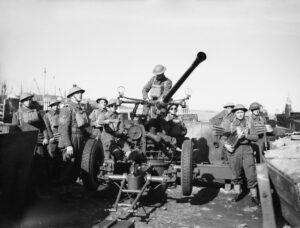 safety. They stayed in an abandoned hotel and shared breakfast. It wasn’t peace exactly, but they formed an uneasy truce, while they waited to see which side would show up to help first.
safety. They stayed in an abandoned hotel and shared breakfast. It wasn’t peace exactly, but they formed an uneasy truce, while they waited to see which side would show up to help first.
Instead of the British or the Germans, it was a Norwegian ski patrol that showed up to rescue the British soldiers, and of course, to take the Germans as POWs. While that one battle seemed to indicate that the British were headed for a victory over the Germans, that was not to be the case. The Germans did finally take over Norway in its entirety. Of course, as we all know, one battle is not a very good indication of who will win the war, and in the end, it was Germany that took a great fall, losing the entirety of World War II.

